Treaties and International Law
VerifiedAdded on 2020/11/23
|15
|2655
|313
Essay
AI Summary
This assignment delves into the intricate world of treaty interpretation within the framework of international law. It examines the provisions of the Vienna Convention on the Law of Treaties, a cornerstone document governing treaty construction and application. Furthermore, it explores pertinent case studies, such as the Case of S.S. Wimbledon, to illustrate the practical implications of treaty interpretation in resolving international disputes. The assignment also touches upon contemporary challenges and evolving perspectives in this field.
Contribute Materials
Your contribution can guide someone’s learning journey. Share your
documents today.
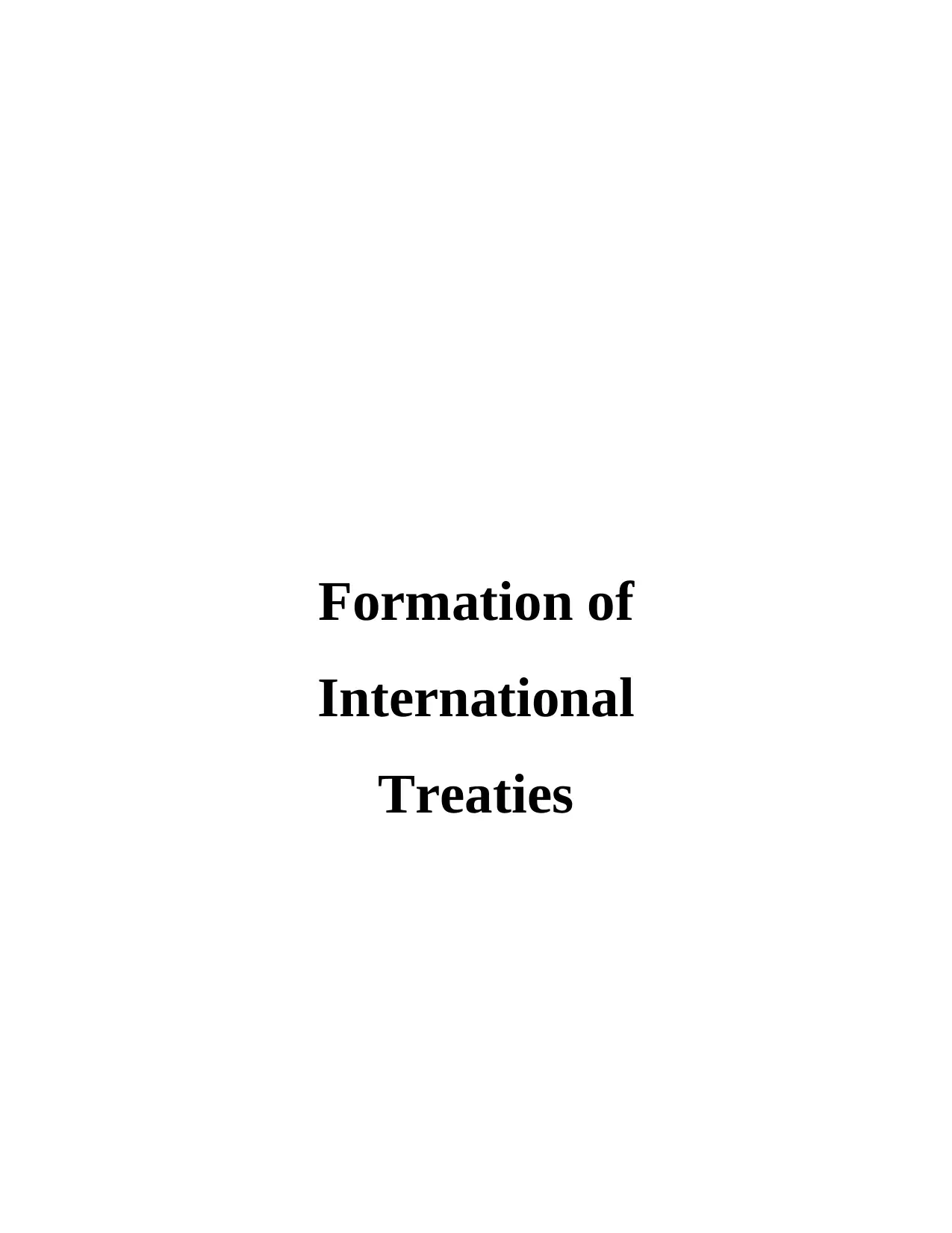
Formation of
International
Treaties
International
Treaties
Secure Best Marks with AI Grader
Need help grading? Try our AI Grader for instant feedback on your assignments.
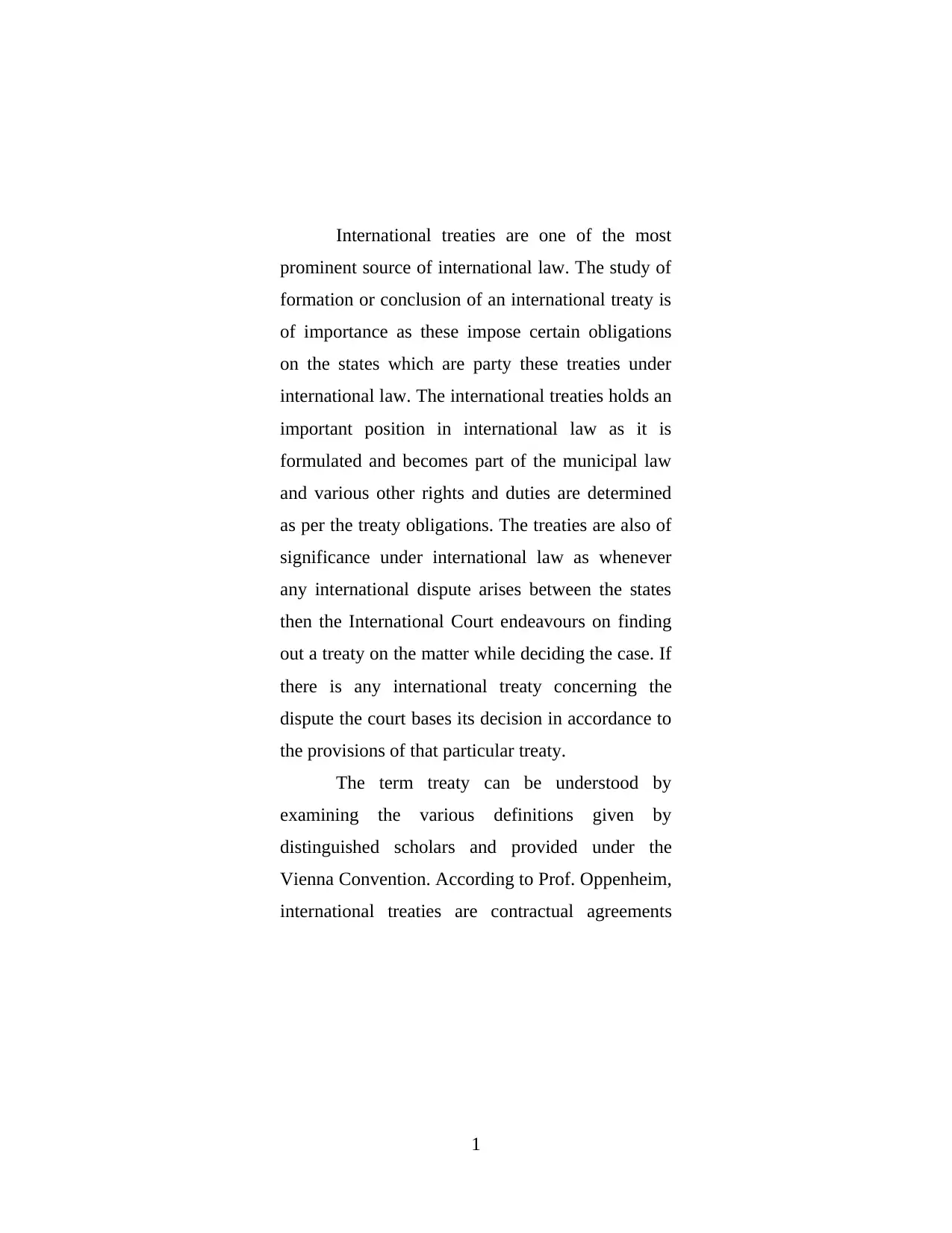
International treaties are one of the most
prominent source of international law. The study of
formation or conclusion of an international treaty is
of importance as these impose certain obligations
on the states which are party these treaties under
international law. The international treaties holds an
important position in international law as it is
formulated and becomes part of the municipal law
and various other rights and duties are determined
as per the treaty obligations. The treaties are also of
significance under international law as whenever
any international dispute arises between the states
then the International Court endeavours on finding
out a treaty on the matter while deciding the case. If
there is any international treaty concerning the
dispute the court bases its decision in accordance to
the provisions of that particular treaty.
The term treaty can be understood by
examining the various definitions given by
distinguished scholars and provided under the
Vienna Convention. According to Prof. Oppenheim,
international treaties are contractual agreements
1
prominent source of international law. The study of
formation or conclusion of an international treaty is
of importance as these impose certain obligations
on the states which are party these treaties under
international law. The international treaties holds an
important position in international law as it is
formulated and becomes part of the municipal law
and various other rights and duties are determined
as per the treaty obligations. The treaties are also of
significance under international law as whenever
any international dispute arises between the states
then the International Court endeavours on finding
out a treaty on the matter while deciding the case. If
there is any international treaty concerning the
dispute the court bases its decision in accordance to
the provisions of that particular treaty.
The term treaty can be understood by
examining the various definitions given by
distinguished scholars and provided under the
Vienna Convention. According to Prof. Oppenheim,
international treaties are contractual agreements
1
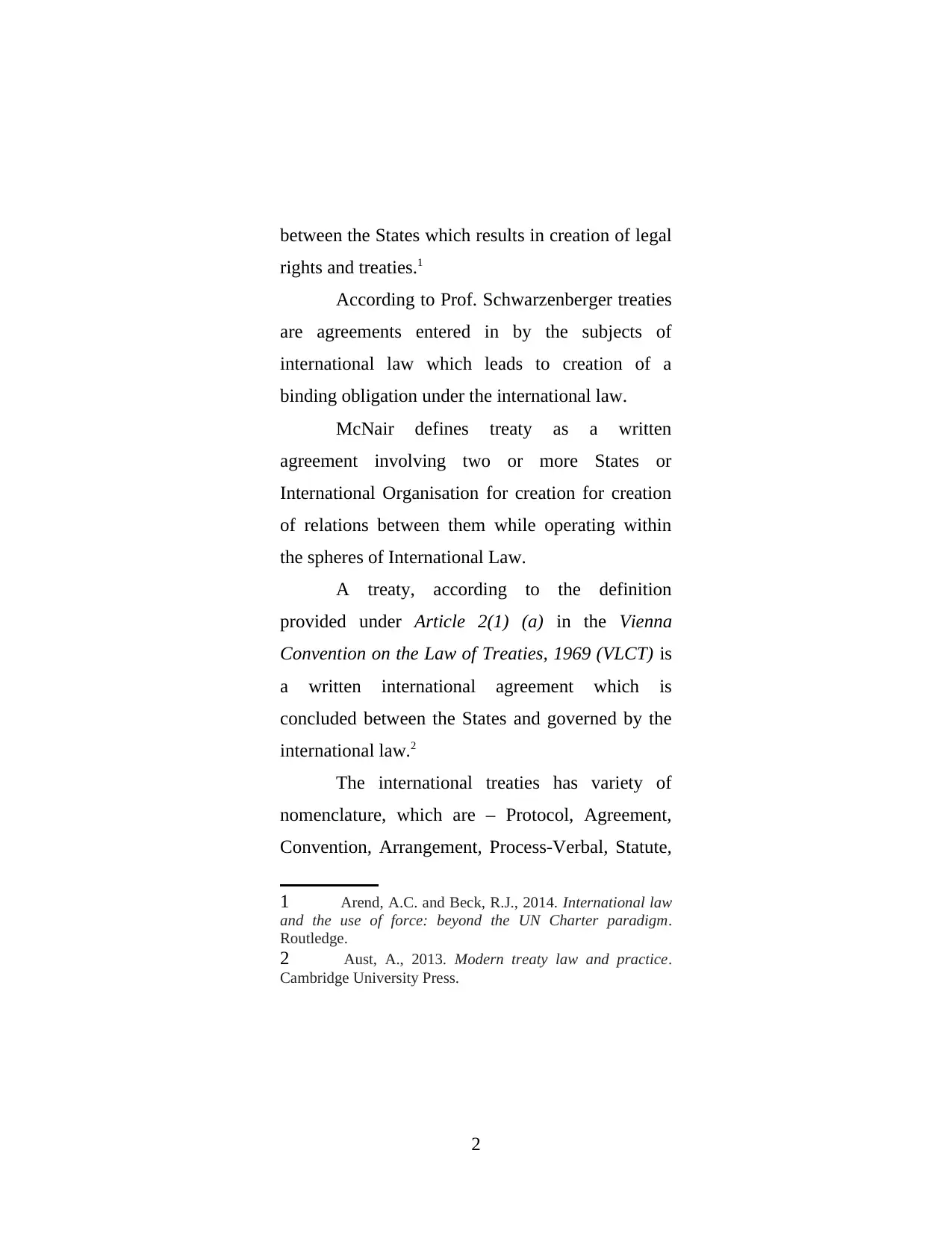
between the States which results in creation of legal
rights and treaties.1
According to Prof. Schwarzenberger treaties
are agreements entered in by the subjects of
international law which leads to creation of a
binding obligation under the international law.
McNair defines treaty as a written
agreement involving two or more States or
International Organisation for creation for creation
of relations between them while operating within
the spheres of International Law.
A treaty, according to the definition
provided under Article 2(1) (a) in the Vienna
Convention on the Law of Treaties, 1969 (VLCT) is
a written international agreement which is
concluded between the States and governed by the
international law.2
The international treaties has variety of
nomenclature, which are – Protocol, Agreement,
Convention, Arrangement, Process-Verbal, Statute,
1 Arend, A.C. and Beck, R.J., 2014. International law
and the use of force: beyond the UN Charter paradigm.
Routledge.
2 Aust, A., 2013. Modern treaty law and practice.
Cambridge University Press.
2
rights and treaties.1
According to Prof. Schwarzenberger treaties
are agreements entered in by the subjects of
international law which leads to creation of a
binding obligation under the international law.
McNair defines treaty as a written
agreement involving two or more States or
International Organisation for creation for creation
of relations between them while operating within
the spheres of International Law.
A treaty, according to the definition
provided under Article 2(1) (a) in the Vienna
Convention on the Law of Treaties, 1969 (VLCT) is
a written international agreement which is
concluded between the States and governed by the
international law.2
The international treaties has variety of
nomenclature, which are – Protocol, Agreement,
Convention, Arrangement, Process-Verbal, Statute,
1 Arend, A.C. and Beck, R.J., 2014. International law
and the use of force: beyond the UN Charter paradigm.
Routledge.
2 Aust, A., 2013. Modern treaty law and practice.
Cambridge University Press.
2
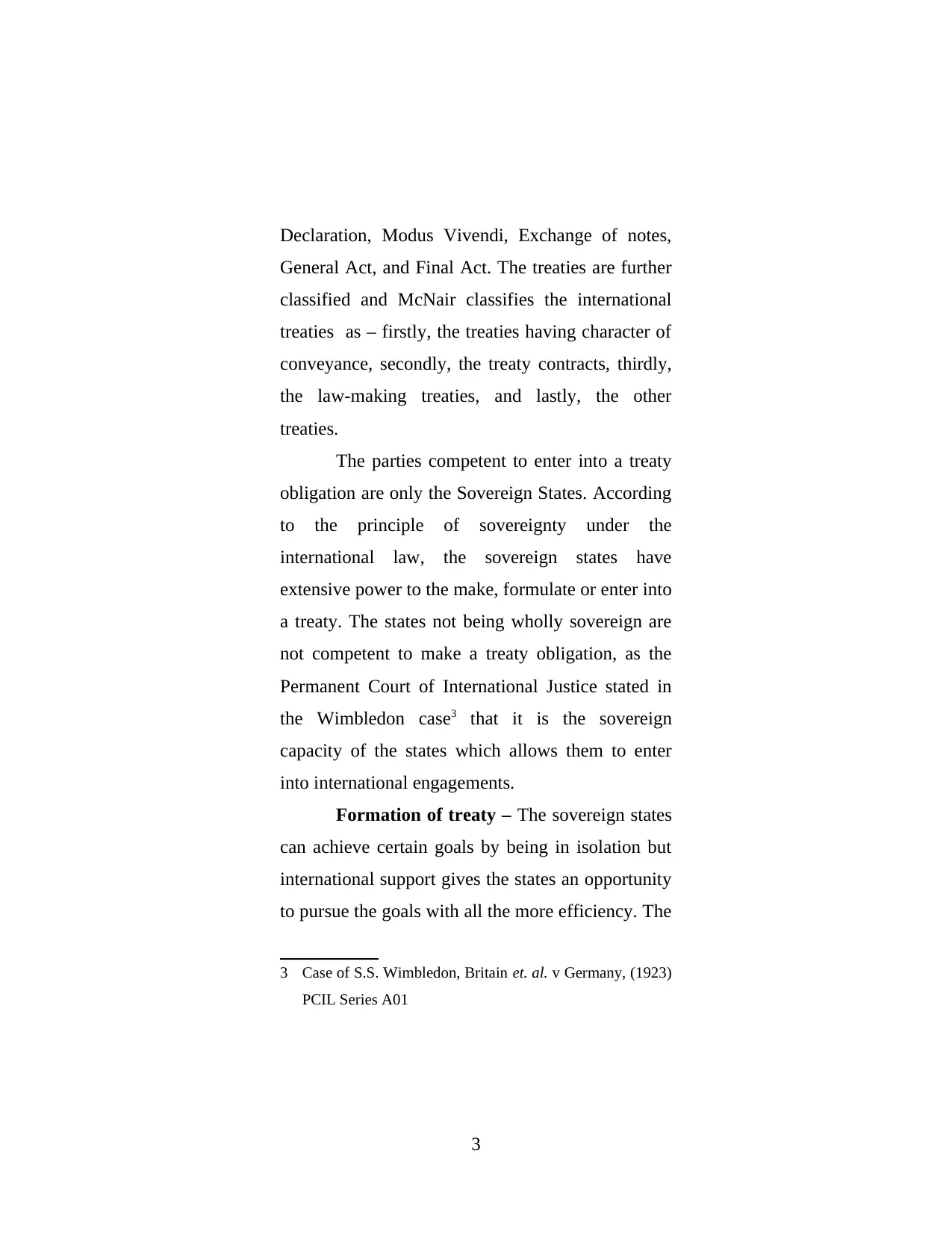
Declaration, Modus Vivendi, Exchange of notes,
General Act, and Final Act. The treaties are further
classified and McNair classifies the international
treaties as – firstly, the treaties having character of
conveyance, secondly, the treaty contracts, thirdly,
the law-making treaties, and lastly, the other
treaties.
The parties competent to enter into a treaty
obligation are only the Sovereign States. According
to the principle of sovereignty under the
international law, the sovereign states have
extensive power to the make, formulate or enter into
a treaty. The states not being wholly sovereign are
not competent to make a treaty obligation, as the
Permanent Court of International Justice stated in
the Wimbledon case3 that it is the sovereign
capacity of the states which allows them to enter
into international engagements.
Formation of treaty – The sovereign states
can achieve certain goals by being in isolation but
international support gives the states an opportunity
to pursue the goals with all the more efficiency. The
3 Case of S.S. Wimbledon, Britain et. al. v Germany, (1923)
PCIL Series A01
3
General Act, and Final Act. The treaties are further
classified and McNair classifies the international
treaties as – firstly, the treaties having character of
conveyance, secondly, the treaty contracts, thirdly,
the law-making treaties, and lastly, the other
treaties.
The parties competent to enter into a treaty
obligation are only the Sovereign States. According
to the principle of sovereignty under the
international law, the sovereign states have
extensive power to the make, formulate or enter into
a treaty. The states not being wholly sovereign are
not competent to make a treaty obligation, as the
Permanent Court of International Justice stated in
the Wimbledon case3 that it is the sovereign
capacity of the states which allows them to enter
into international engagements.
Formation of treaty – The sovereign states
can achieve certain goals by being in isolation but
international support gives the states an opportunity
to pursue the goals with all the more efficiency. The
3 Case of S.S. Wimbledon, Britain et. al. v Germany, (1923)
PCIL Series A01
3
Secure Best Marks with AI Grader
Need help grading? Try our AI Grader for instant feedback on your assignments.
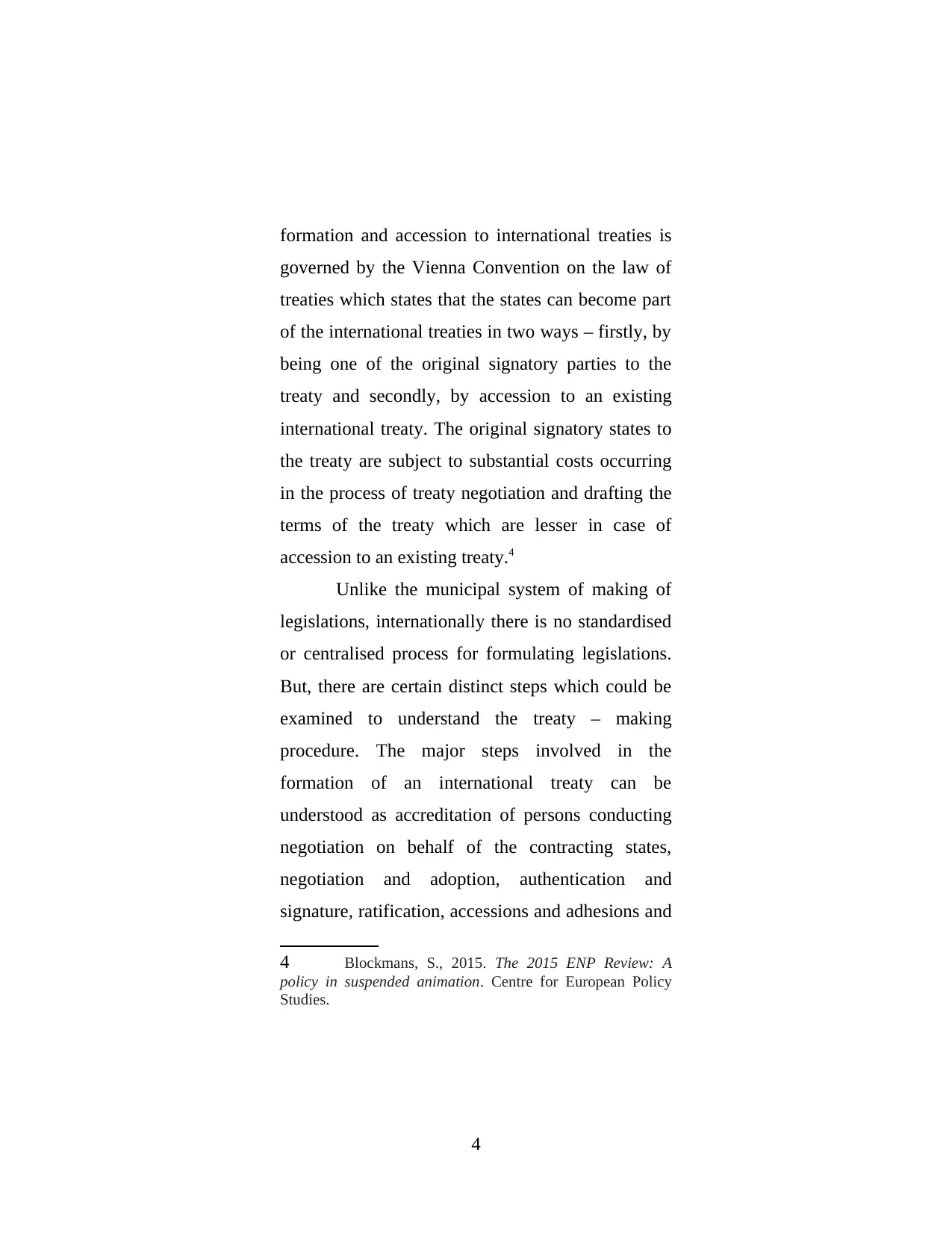
formation and accession to international treaties is
governed by the Vienna Convention on the law of
treaties which states that the states can become part
of the international treaties in two ways – firstly, by
being one of the original signatory parties to the
treaty and secondly, by accession to an existing
international treaty. The original signatory states to
the treaty are subject to substantial costs occurring
in the process of treaty negotiation and drafting the
terms of the treaty which are lesser in case of
accession to an existing treaty.4
Unlike the municipal system of making of
legislations, internationally there is no standardised
or centralised process for formulating legislations.
But, there are certain distinct steps which could be
examined to understand the treaty – making
procedure. The major steps involved in the
formation of an international treaty can be
understood as accreditation of persons conducting
negotiation on behalf of the contracting states,
negotiation and adoption, authentication and
signature, ratification, accessions and adhesions and
4 Blockmans, S., 2015. The 2015 ENP Review: A
policy in suspended animation. Centre for European Policy
Studies.
4
governed by the Vienna Convention on the law of
treaties which states that the states can become part
of the international treaties in two ways – firstly, by
being one of the original signatory parties to the
treaty and secondly, by accession to an existing
international treaty. The original signatory states to
the treaty are subject to substantial costs occurring
in the process of treaty negotiation and drafting the
terms of the treaty which are lesser in case of
accession to an existing treaty.4
Unlike the municipal system of making of
legislations, internationally there is no standardised
or centralised process for formulating legislations.
But, there are certain distinct steps which could be
examined to understand the treaty – making
procedure. The major steps involved in the
formation of an international treaty can be
understood as accreditation of persons conducting
negotiation on behalf of the contracting states,
negotiation and adoption, authentication and
signature, ratification, accessions and adhesions and
4 Blockmans, S., 2015. The 2015 ENP Review: A
policy in suspended animation. Centre for European Policy
Studies.
4
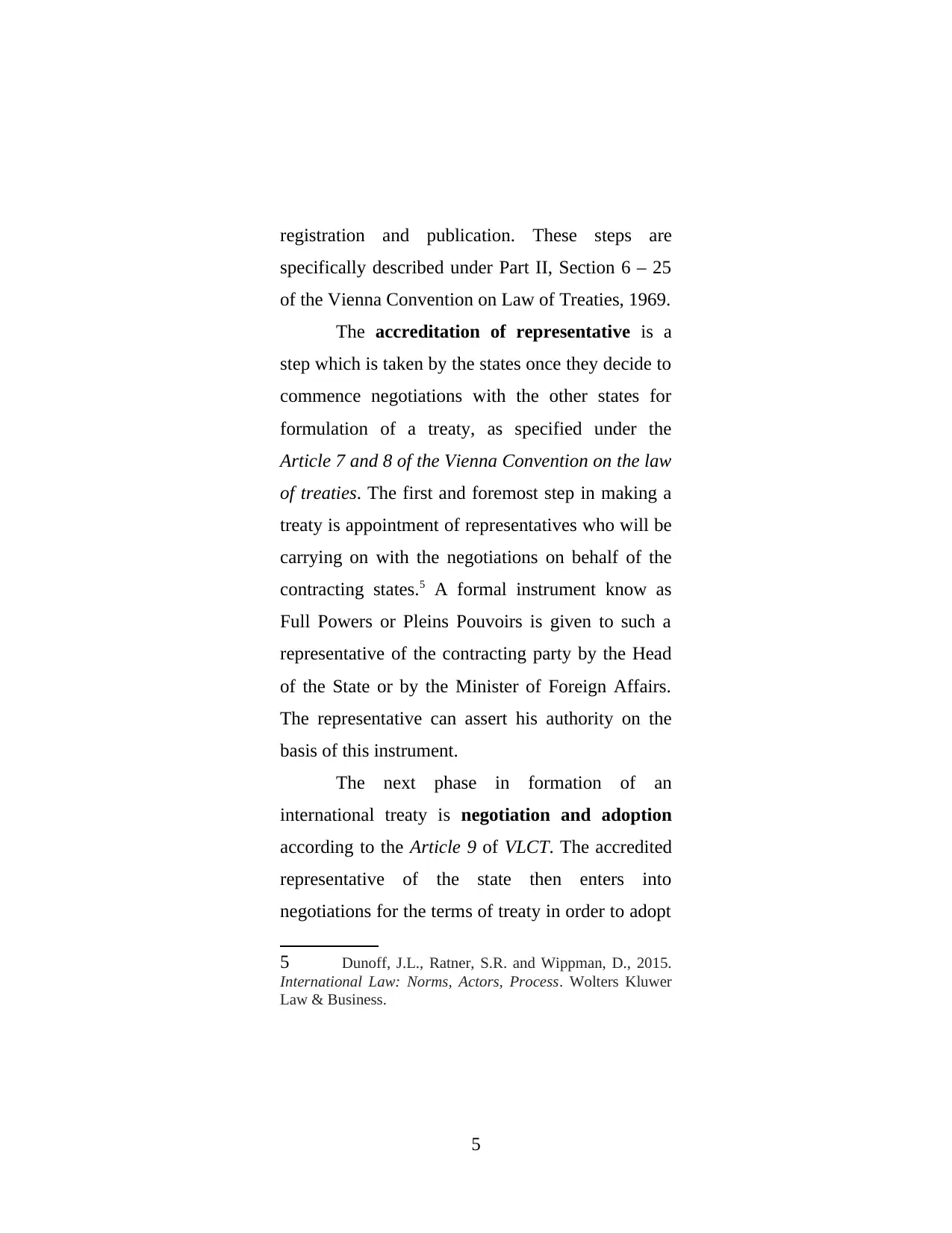
registration and publication. These steps are
specifically described under Part II, Section 6 – 25
of the Vienna Convention on Law of Treaties, 1969.
The accreditation of representative is a
step which is taken by the states once they decide to
commence negotiations with the other states for
formulation of a treaty, as specified under the
Article 7 and 8 of the Vienna Convention on the law
of treaties. The first and foremost step in making a
treaty is appointment of representatives who will be
carrying on with the negotiations on behalf of the
contracting states.5 A formal instrument know as
Full Powers or Pleins Pouvoirs is given to such a
representative of the contracting party by the Head
of the State or by the Minister of Foreign Affairs.
The representative can assert his authority on the
basis of this instrument.
The next phase in formation of an
international treaty is negotiation and adoption
according to the Article 9 of VLCT. The accredited
representative of the state then enters into
negotiations for the terms of treaty in order to adopt
5 Dunoff, J.L., Ratner, S.R. and Wippman, D., 2015.
International Law: Norms, Actors, Process. Wolters Kluwer
Law & Business.
5
specifically described under Part II, Section 6 – 25
of the Vienna Convention on Law of Treaties, 1969.
The accreditation of representative is a
step which is taken by the states once they decide to
commence negotiations with the other states for
formulation of a treaty, as specified under the
Article 7 and 8 of the Vienna Convention on the law
of treaties. The first and foremost step in making a
treaty is appointment of representatives who will be
carrying on with the negotiations on behalf of the
contracting states.5 A formal instrument know as
Full Powers or Pleins Pouvoirs is given to such a
representative of the contracting party by the Head
of the State or by the Minister of Foreign Affairs.
The representative can assert his authority on the
basis of this instrument.
The next phase in formation of an
international treaty is negotiation and adoption
according to the Article 9 of VLCT. The accredited
representative of the state then enters into
negotiations for the terms of treaty in order to adopt
5 Dunoff, J.L., Ratner, S.R. and Wippman, D., 2015.
International Law: Norms, Actors, Process. Wolters Kluwer
Law & Business.
5
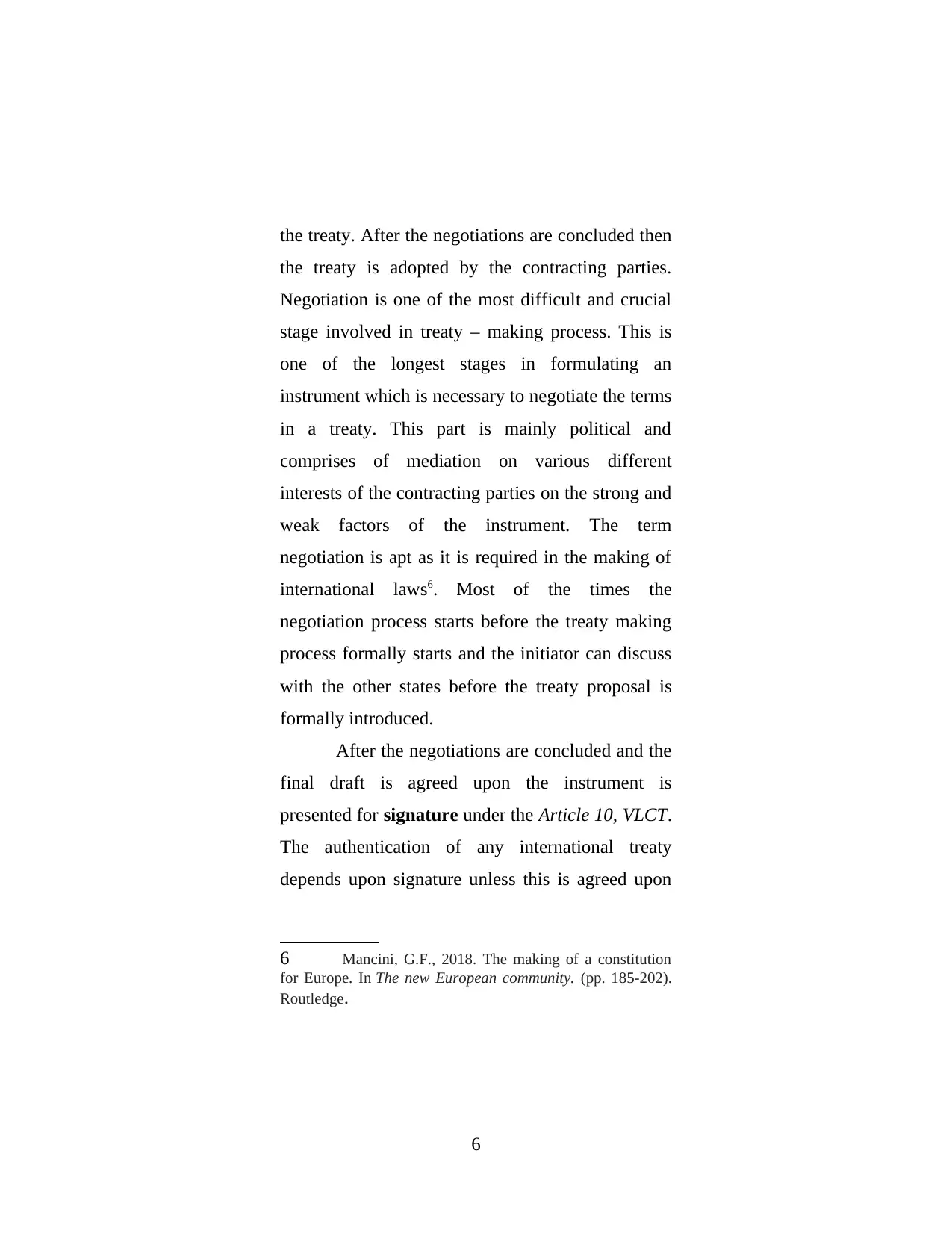
the treaty. After the negotiations are concluded then
the treaty is adopted by the contracting parties.
Negotiation is one of the most difficult and crucial
stage involved in treaty – making process. This is
one of the longest stages in formulating an
instrument which is necessary to negotiate the terms
in a treaty. This part is mainly political and
comprises of mediation on various different
interests of the contracting parties on the strong and
weak factors of the instrument. The term
negotiation is apt as it is required in the making of
international laws6. Most of the times the
negotiation process starts before the treaty making
process formally starts and the initiator can discuss
with the other states before the treaty proposal is
formally introduced.
After the negotiations are concluded and the
final draft is agreed upon the instrument is
presented for signature under the Article 10, VLCT.
The authentication of any international treaty
depends upon signature unless this is agreed upon
6 Mancini, G.F., 2018. The making of a constitution
for Europe. In The new European community. (pp. 185-202).
Routledge.
6
the treaty is adopted by the contracting parties.
Negotiation is one of the most difficult and crucial
stage involved in treaty – making process. This is
one of the longest stages in formulating an
instrument which is necessary to negotiate the terms
in a treaty. This part is mainly political and
comprises of mediation on various different
interests of the contracting parties on the strong and
weak factors of the instrument. The term
negotiation is apt as it is required in the making of
international laws6. Most of the times the
negotiation process starts before the treaty making
process formally starts and the initiator can discuss
with the other states before the treaty proposal is
formally introduced.
After the negotiations are concluded and the
final draft is agreed upon the instrument is
presented for signature under the Article 10, VLCT.
The authentication of any international treaty
depends upon signature unless this is agreed upon
6 Mancini, G.F., 2018. The making of a constitution
for Europe. In The new European community. (pp. 185-202).
Routledge.
6
Paraphrase This Document
Need a fresh take? Get an instant paraphrase of this document with our AI Paraphraser
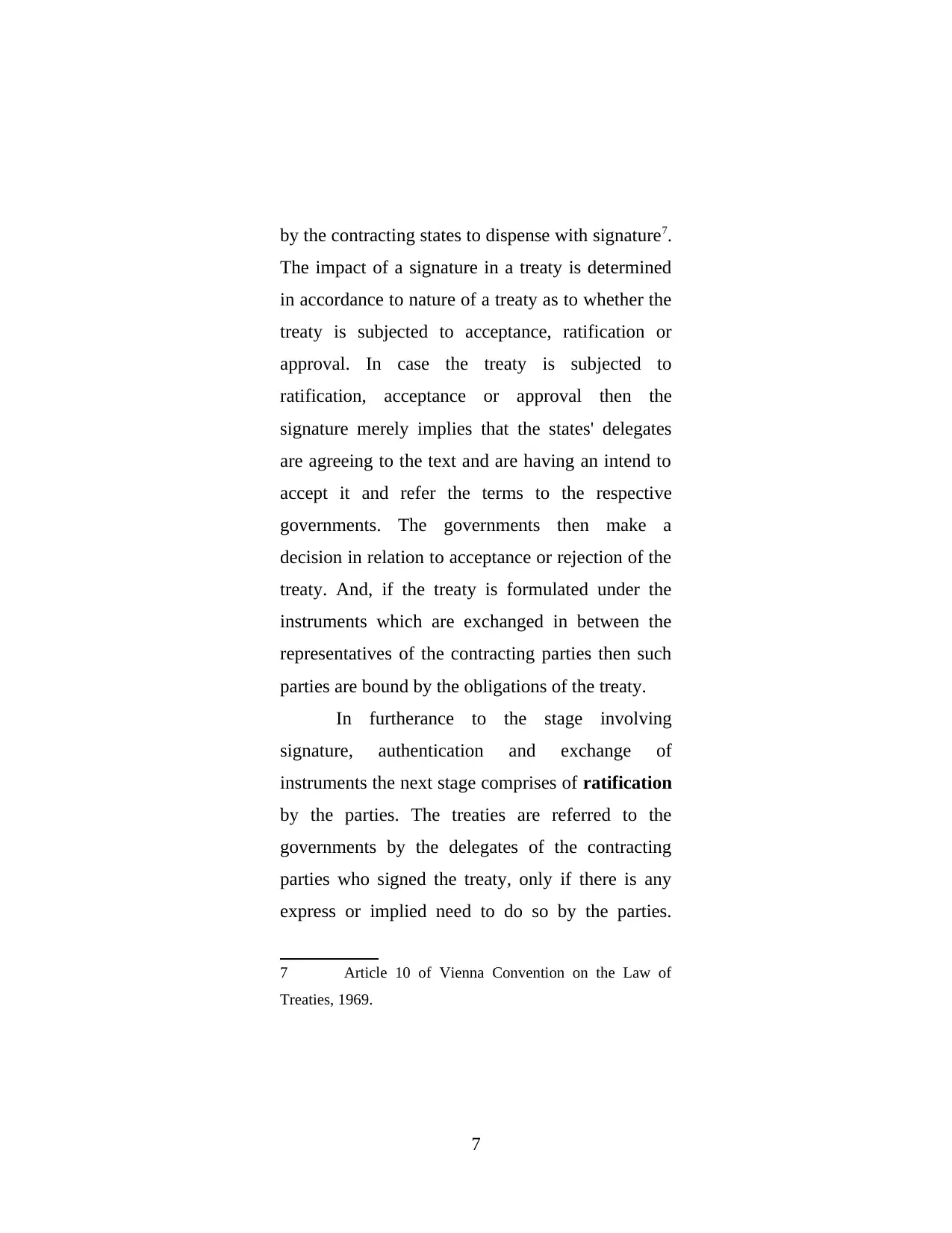
by the contracting states to dispense with signature7.
The impact of a signature in a treaty is determined
in accordance to nature of a treaty as to whether the
treaty is subjected to acceptance, ratification or
approval. In case the treaty is subjected to
ratification, acceptance or approval then the
signature merely implies that the states' delegates
are agreeing to the text and are having an intend to
accept it and refer the terms to the respective
governments. The governments then make a
decision in relation to acceptance or rejection of the
treaty. And, if the treaty is formulated under the
instruments which are exchanged in between the
representatives of the contracting parties then such
parties are bound by the obligations of the treaty.
In furtherance to the stage involving
signature, authentication and exchange of
instruments the next stage comprises of ratification
by the parties. The treaties are referred to the
governments by the delegates of the contracting
parties who signed the treaty, only if there is any
express or implied need to do so by the parties.
7 Article 10 of Vienna Convention on the Law of
Treaties, 1969.
7
The impact of a signature in a treaty is determined
in accordance to nature of a treaty as to whether the
treaty is subjected to acceptance, ratification or
approval. In case the treaty is subjected to
ratification, acceptance or approval then the
signature merely implies that the states' delegates
are agreeing to the text and are having an intend to
accept it and refer the terms to the respective
governments. The governments then make a
decision in relation to acceptance or rejection of the
treaty. And, if the treaty is formulated under the
instruments which are exchanged in between the
representatives of the contracting parties then such
parties are bound by the obligations of the treaty.
In furtherance to the stage involving
signature, authentication and exchange of
instruments the next stage comprises of ratification
by the parties. The treaties are referred to the
governments by the delegates of the contracting
parties who signed the treaty, only if there is any
express or implied need to do so by the parties.
7 Article 10 of Vienna Convention on the Law of
Treaties, 1969.
7
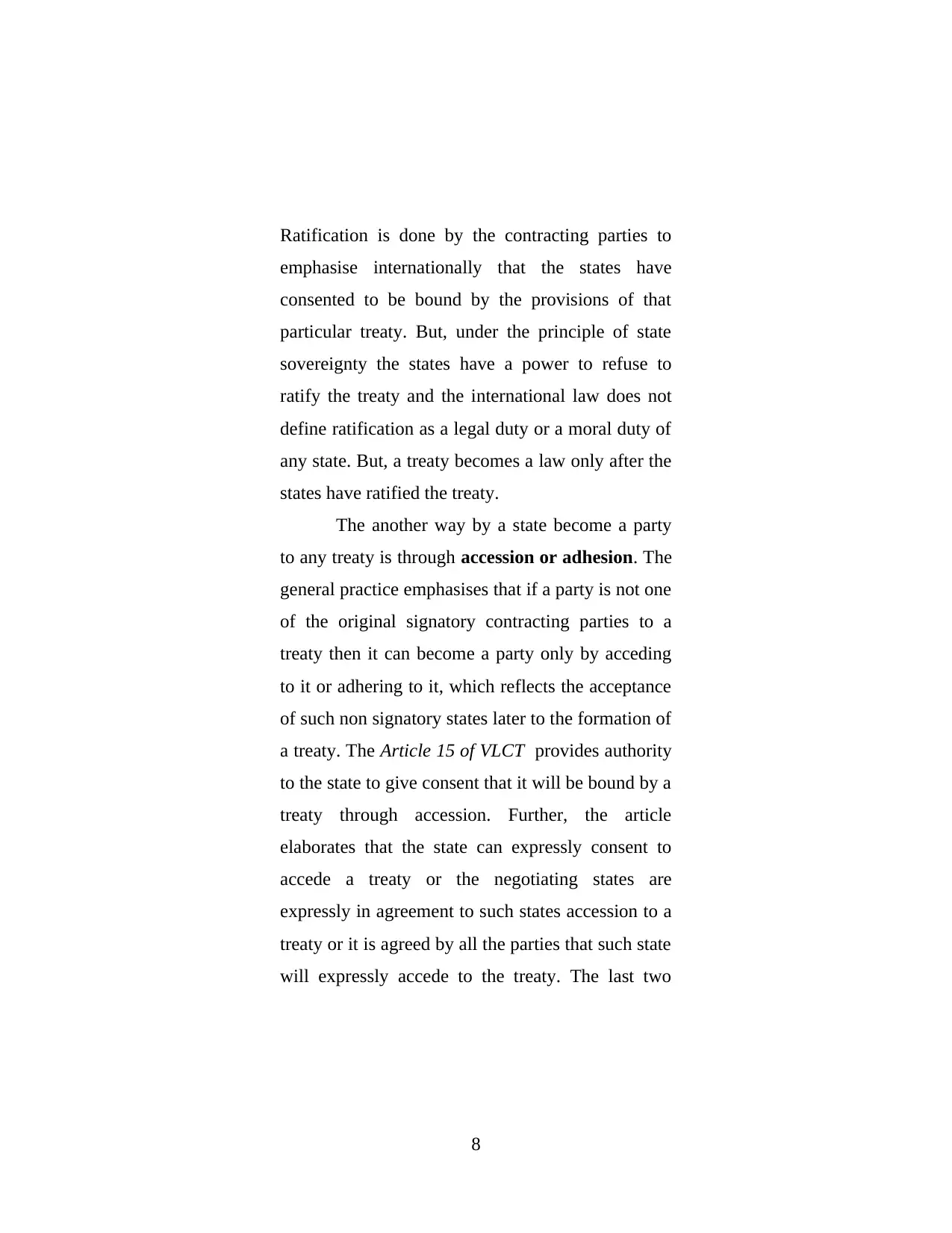
Ratification is done by the contracting parties to
emphasise internationally that the states have
consented to be bound by the provisions of that
particular treaty. But, under the principle of state
sovereignty the states have a power to refuse to
ratify the treaty and the international law does not
define ratification as a legal duty or a moral duty of
any state. But, a treaty becomes a law only after the
states have ratified the treaty.
The another way by a state become a party
to any treaty is through accession or adhesion. The
general practice emphasises that if a party is not one
of the original signatory contracting parties to a
treaty then it can become a party only by acceding
to it or adhering to it, which reflects the acceptance
of such non signatory states later to the formation of
a treaty. The Article 15 of VLCT provides authority
to the state to give consent that it will be bound by a
treaty through accession. Further, the article
elaborates that the state can expressly consent to
accede a treaty or the negotiating states are
expressly in agreement to such states accession to a
treaty or it is agreed by all the parties that such state
will expressly accede to the treaty. The last two
8
emphasise internationally that the states have
consented to be bound by the provisions of that
particular treaty. But, under the principle of state
sovereignty the states have a power to refuse to
ratify the treaty and the international law does not
define ratification as a legal duty or a moral duty of
any state. But, a treaty becomes a law only after the
states have ratified the treaty.
The another way by a state become a party
to any treaty is through accession or adhesion. The
general practice emphasises that if a party is not one
of the original signatory contracting parties to a
treaty then it can become a party only by acceding
to it or adhering to it, which reflects the acceptance
of such non signatory states later to the formation of
a treaty. The Article 15 of VLCT provides authority
to the state to give consent that it will be bound by a
treaty through accession. Further, the article
elaborates that the state can expressly consent to
accede a treaty or the negotiating states are
expressly in agreement to such states accession to a
treaty or it is agreed by all the parties that such state
will expressly accede to the treaty. The last two
8
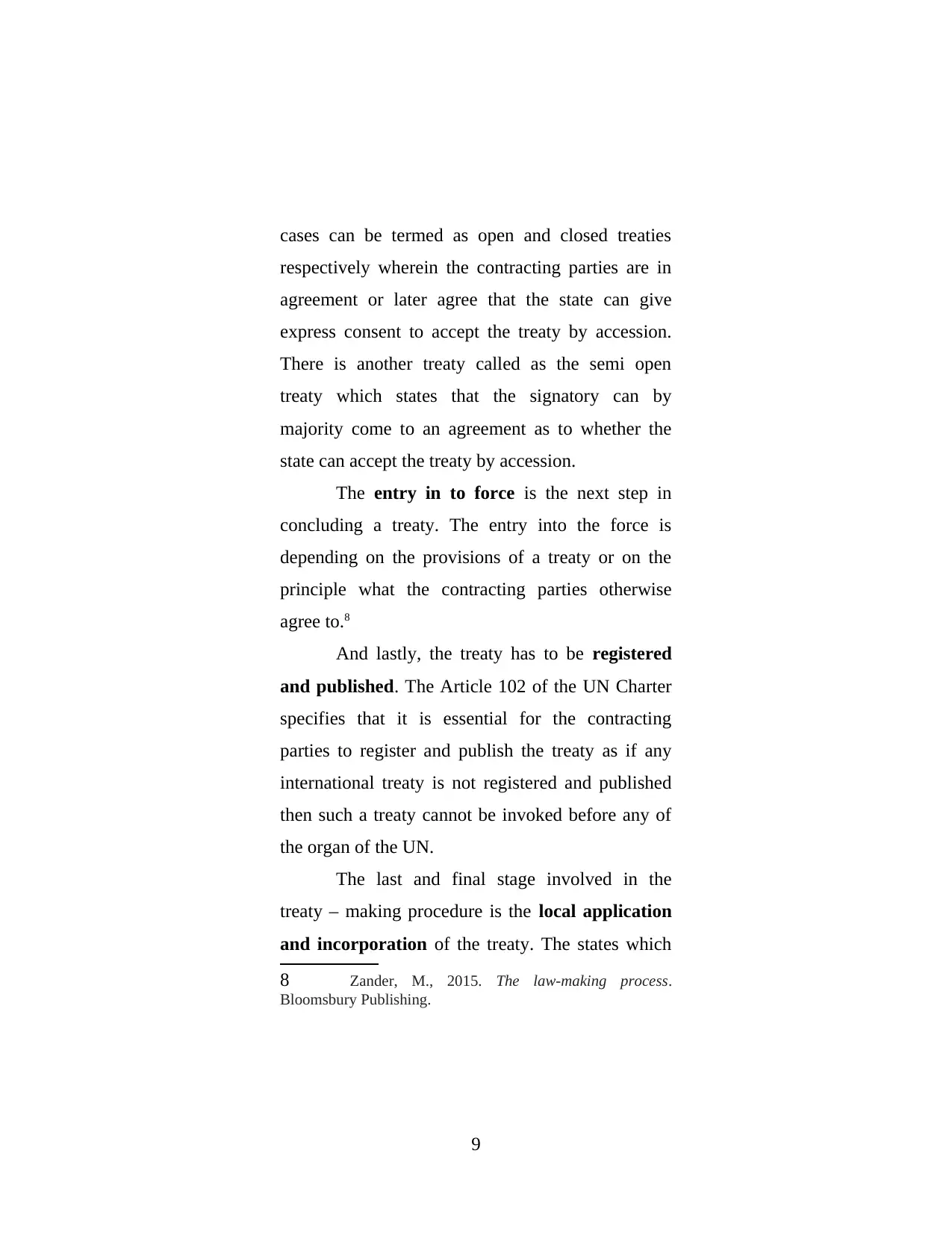
cases can be termed as open and closed treaties
respectively wherein the contracting parties are in
agreement or later agree that the state can give
express consent to accept the treaty by accession.
There is another treaty called as the semi open
treaty which states that the signatory can by
majority come to an agreement as to whether the
state can accept the treaty by accession.
The entry in to force is the next step in
concluding a treaty. The entry into the force is
depending on the provisions of a treaty or on the
principle what the contracting parties otherwise
agree to.8
And lastly, the treaty has to be registered
and published. The Article 102 of the UN Charter
specifies that it is essential for the contracting
parties to register and publish the treaty as if any
international treaty is not registered and published
then such a treaty cannot be invoked before any of
the organ of the UN.
The last and final stage involved in the
treaty – making procedure is the local application
and incorporation of the treaty. The states which
8 Zander, M., 2015. The law-making process.
Bloomsbury Publishing.
9
respectively wherein the contracting parties are in
agreement or later agree that the state can give
express consent to accept the treaty by accession.
There is another treaty called as the semi open
treaty which states that the signatory can by
majority come to an agreement as to whether the
state can accept the treaty by accession.
The entry in to force is the next step in
concluding a treaty. The entry into the force is
depending on the provisions of a treaty or on the
principle what the contracting parties otherwise
agree to.8
And lastly, the treaty has to be registered
and published. The Article 102 of the UN Charter
specifies that it is essential for the contracting
parties to register and publish the treaty as if any
international treaty is not registered and published
then such a treaty cannot be invoked before any of
the organ of the UN.
The last and final stage involved in the
treaty – making procedure is the local application
and incorporation of the treaty. The states which
8 Zander, M., 2015. The law-making process.
Bloomsbury Publishing.
9
Secure Best Marks with AI Grader
Need help grading? Try our AI Grader for instant feedback on your assignments.
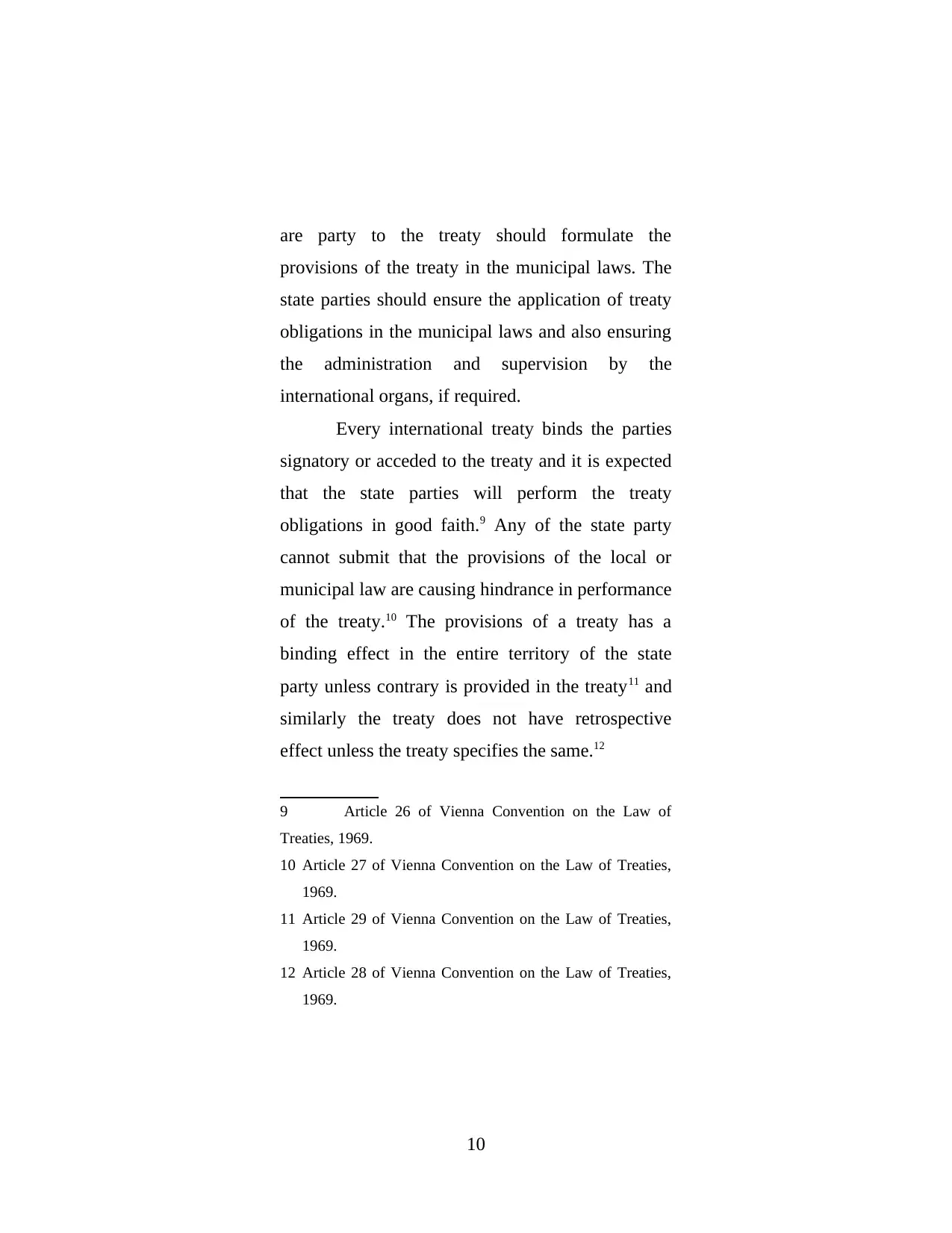
are party to the treaty should formulate the
provisions of the treaty in the municipal laws. The
state parties should ensure the application of treaty
obligations in the municipal laws and also ensuring
the administration and supervision by the
international organs, if required.
Every international treaty binds the parties
signatory or acceded to the treaty and it is expected
that the state parties will perform the treaty
obligations in good faith.9 Any of the state party
cannot submit that the provisions of the local or
municipal law are causing hindrance in performance
of the treaty.10 The provisions of a treaty has a
binding effect in the entire territory of the state
party unless contrary is provided in the treaty11 and
similarly the treaty does not have retrospective
effect unless the treaty specifies the same.12
9 Article 26 of Vienna Convention on the Law of
Treaties, 1969.
10 Article 27 of Vienna Convention on the Law of Treaties,
1969.
11 Article 29 of Vienna Convention on the Law of Treaties,
1969.
12 Article 28 of Vienna Convention on the Law of Treaties,
1969.
10
provisions of the treaty in the municipal laws. The
state parties should ensure the application of treaty
obligations in the municipal laws and also ensuring
the administration and supervision by the
international organs, if required.
Every international treaty binds the parties
signatory or acceded to the treaty and it is expected
that the state parties will perform the treaty
obligations in good faith.9 Any of the state party
cannot submit that the provisions of the local or
municipal law are causing hindrance in performance
of the treaty.10 The provisions of a treaty has a
binding effect in the entire territory of the state
party unless contrary is provided in the treaty11 and
similarly the treaty does not have retrospective
effect unless the treaty specifies the same.12
9 Article 26 of Vienna Convention on the Law of
Treaties, 1969.
10 Article 27 of Vienna Convention on the Law of Treaties,
1969.
11 Article 29 of Vienna Convention on the Law of Treaties,
1969.
12 Article 28 of Vienna Convention on the Law of Treaties,
1969.
10
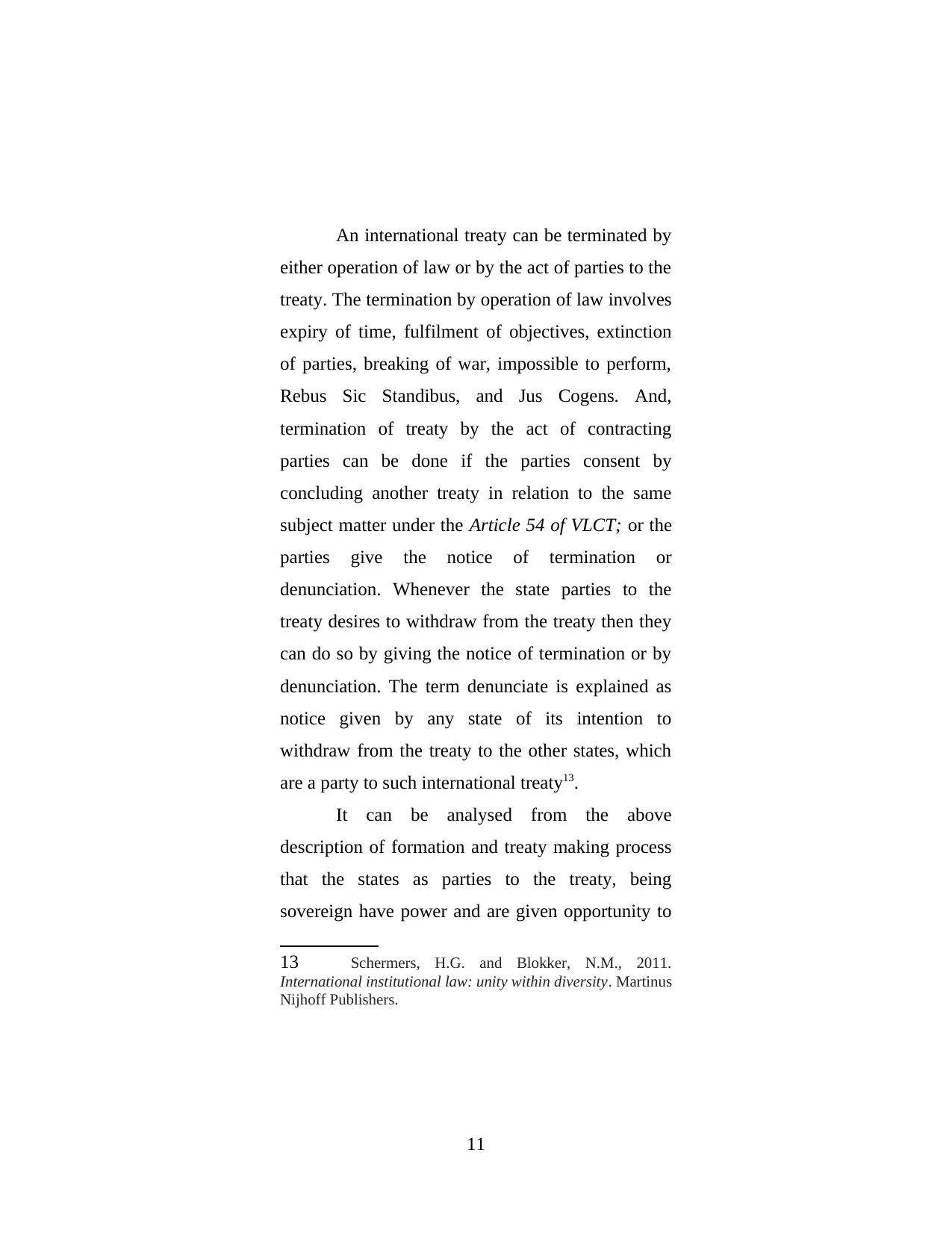
An international treaty can be terminated by
either operation of law or by the act of parties to the
treaty. The termination by operation of law involves
expiry of time, fulfilment of objectives, extinction
of parties, breaking of war, impossible to perform,
Rebus Sic Standibus, and Jus Cogens. And,
termination of treaty by the act of contracting
parties can be done if the parties consent by
concluding another treaty in relation to the same
subject matter under the Article 54 of VLCT; or the
parties give the notice of termination or
denunciation. Whenever the state parties to the
treaty desires to withdraw from the treaty then they
can do so by giving the notice of termination or by
denunciation. The term denunciate is explained as
notice given by any state of its intention to
withdraw from the treaty to the other states, which
are a party to such international treaty13.
It can be analysed from the above
description of formation and treaty making process
that the states as parties to the treaty, being
sovereign have power and are given opportunity to
13 Schermers, H.G. and Blokker, N.M., 2011.
International institutional law: unity within diversity. Martinus
Nijhoff Publishers.
11
either operation of law or by the act of parties to the
treaty. The termination by operation of law involves
expiry of time, fulfilment of objectives, extinction
of parties, breaking of war, impossible to perform,
Rebus Sic Standibus, and Jus Cogens. And,
termination of treaty by the act of contracting
parties can be done if the parties consent by
concluding another treaty in relation to the same
subject matter under the Article 54 of VLCT; or the
parties give the notice of termination or
denunciation. Whenever the state parties to the
treaty desires to withdraw from the treaty then they
can do so by giving the notice of termination or by
denunciation. The term denunciate is explained as
notice given by any state of its intention to
withdraw from the treaty to the other states, which
are a party to such international treaty13.
It can be analysed from the above
description of formation and treaty making process
that the states as parties to the treaty, being
sovereign have power and are given opportunity to
13 Schermers, H.G. and Blokker, N.M., 2011.
International institutional law: unity within diversity. Martinus
Nijhoff Publishers.
11
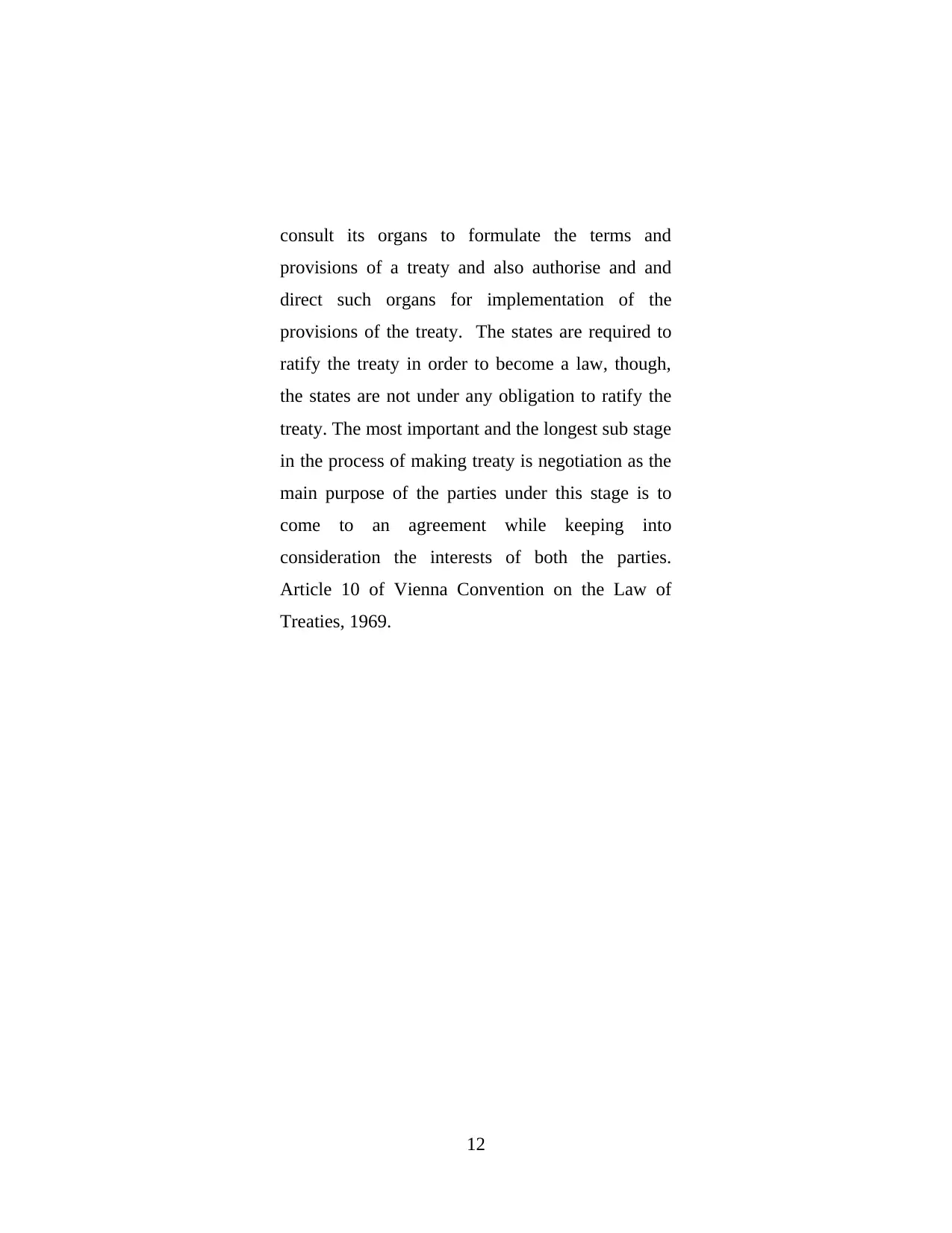
consult its organs to formulate the terms and
provisions of a treaty and also authorise and and
direct such organs for implementation of the
provisions of the treaty. The states are required to
ratify the treaty in order to become a law, though,
the states are not under any obligation to ratify the
treaty. The most important and the longest sub stage
in the process of making treaty is negotiation as the
main purpose of the parties under this stage is to
come to an agreement while keeping into
consideration the interests of both the parties.
Article 10 of Vienna Convention on the Law of
Treaties, 1969.
12
provisions of a treaty and also authorise and and
direct such organs for implementation of the
provisions of the treaty. The states are required to
ratify the treaty in order to become a law, though,
the states are not under any obligation to ratify the
treaty. The most important and the longest sub stage
in the process of making treaty is negotiation as the
main purpose of the parties under this stage is to
come to an agreement while keeping into
consideration the interests of both the parties.
Article 10 of Vienna Convention on the Law of
Treaties, 1969.
12
Paraphrase This Document
Need a fresh take? Get an instant paraphrase of this document with our AI Paraphraser
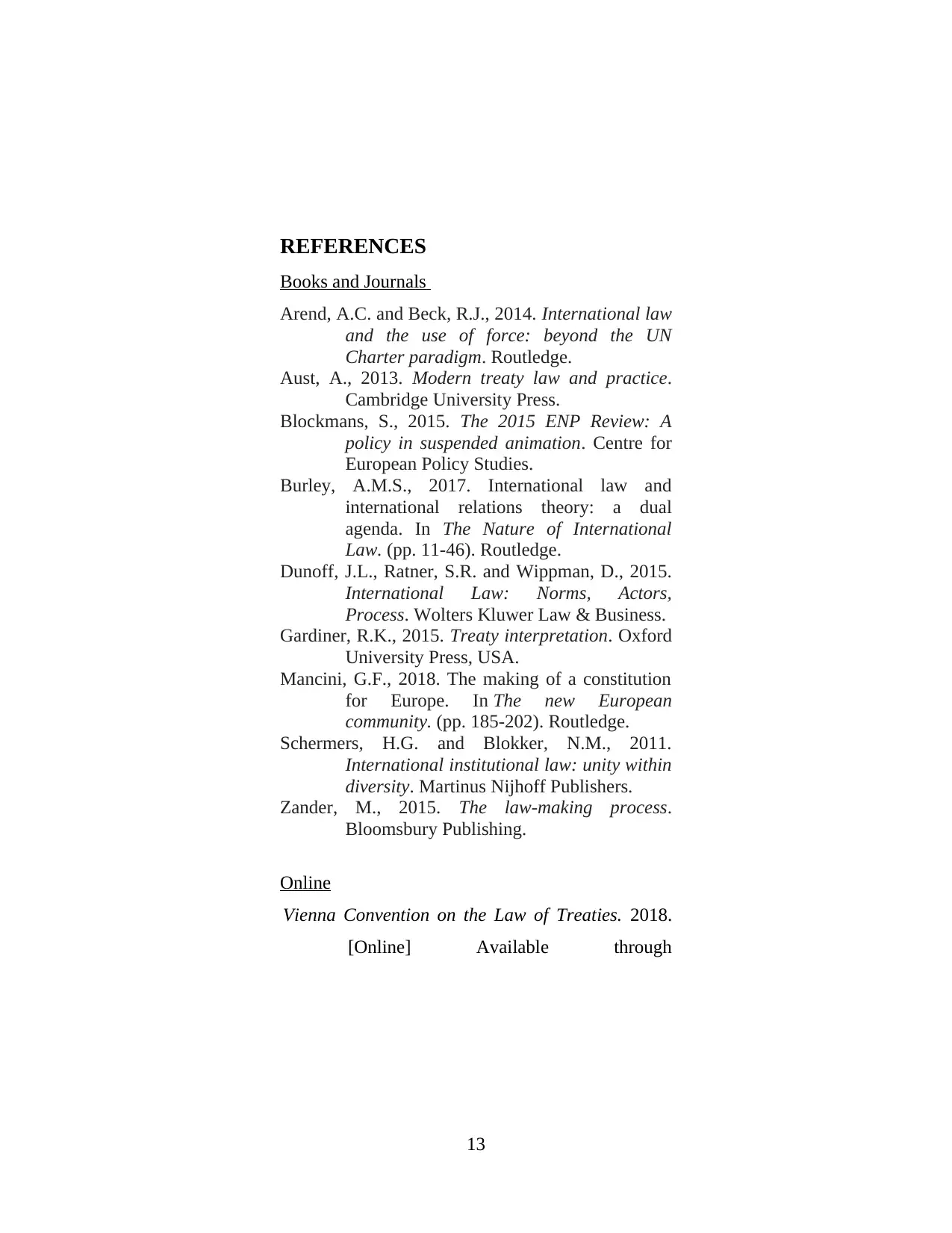
REFERENCES
Books and Journals
Arend, A.C. and Beck, R.J., 2014. International law
and the use of force: beyond the UN
Charter paradigm. Routledge.
Aust, A., 2013. Modern treaty law and practice.
Cambridge University Press.
Blockmans, S., 2015. The 2015 ENP Review: A
policy in suspended animation. Centre for
European Policy Studies.
Burley, A.M.S., 2017. International law and
international relations theory: a dual
agenda. In The Nature of International
Law. (pp. 11-46). Routledge.
Dunoff, J.L., Ratner, S.R. and Wippman, D., 2015.
International Law: Norms, Actors,
Process. Wolters Kluwer Law & Business.
Gardiner, R.K., 2015. Treaty interpretation. Oxford
University Press, USA.
Mancini, G.F., 2018. The making of a constitution
for Europe. In The new European
community. (pp. 185-202). Routledge.
Schermers, H.G. and Blokker, N.M., 2011.
International institutional law: unity within
diversity. Martinus Nijhoff Publishers.
Zander, M., 2015. The law-making process.
Bloomsbury Publishing.
Online
Vienna Convention on the Law of Treaties. 2018.
[Online] Available through
13
Books and Journals
Arend, A.C. and Beck, R.J., 2014. International law
and the use of force: beyond the UN
Charter paradigm. Routledge.
Aust, A., 2013. Modern treaty law and practice.
Cambridge University Press.
Blockmans, S., 2015. The 2015 ENP Review: A
policy in suspended animation. Centre for
European Policy Studies.
Burley, A.M.S., 2017. International law and
international relations theory: a dual
agenda. In The Nature of International
Law. (pp. 11-46). Routledge.
Dunoff, J.L., Ratner, S.R. and Wippman, D., 2015.
International Law: Norms, Actors,
Process. Wolters Kluwer Law & Business.
Gardiner, R.K., 2015. Treaty interpretation. Oxford
University Press, USA.
Mancini, G.F., 2018. The making of a constitution
for Europe. In The new European
community. (pp. 185-202). Routledge.
Schermers, H.G. and Blokker, N.M., 2011.
International institutional law: unity within
diversity. Martinus Nijhoff Publishers.
Zander, M., 2015. The law-making process.
Bloomsbury Publishing.
Online
Vienna Convention on the Law of Treaties. 2018.
[Online] Available through
13

<https://www.britannica.com/topic/Vienna
-Convention-on-the-Law-of-Treaties>
14
-Convention-on-the-Law-of-Treaties>
14
1 out of 15
Related Documents
Your All-in-One AI-Powered Toolkit for Academic Success.
+13062052269
info@desklib.com
Available 24*7 on WhatsApp / Email
![[object Object]](/_next/static/media/star-bottom.7253800d.svg)
Unlock your academic potential
© 2024 | Zucol Services PVT LTD | All rights reserved.





